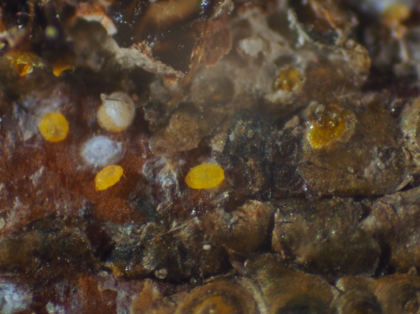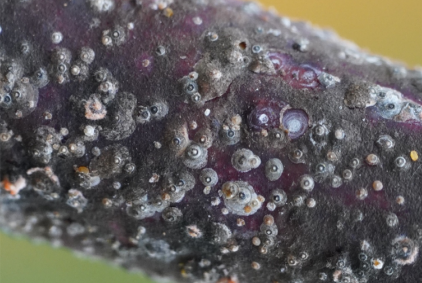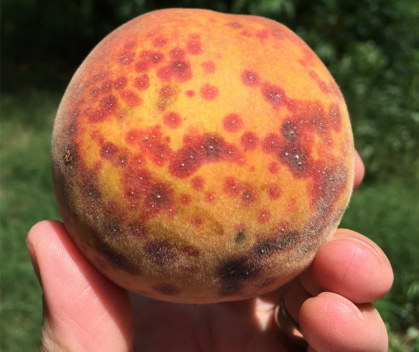Comstockaspis perniciosus
Author: Brett Blaauw, Fruit Entomologist, University of Georgia, 2021
Description
Immature stages: The mobile stage of San Jose scale (SJS) immatures, known as ‘crawlers,’ are yellow, somewhat oval, and minute at about 1/100 inch long.
Adult stages: Adult females are yellow, circular, sac-like insects. They secrete and live beneath a protective round gray-brown covering (1/16 in) that is made up of concentric rings surrounding a raised bump near the center. Adult males are tiny, golden-brown, two-winged insects, about 1/25 in. long with a narrow, dark band across the abdomen. They mature under oval, waxy coverings, about 1/24 inch long with a raised, dark bump near one end.
Biology
Life Cycle: Overwinter in immature life stages beneath protective coverings. The scale insects remain inactive until sap flow begins in spring and development resumes as temperatures reach 51°F. Females remain stationary beneath covering throughout their lives. Males are tiny, winged insects that seek out females to mate. In central Georgia, males emerge from beneath their covering in early spring and 4-5 weeks after mating (approx. early April), females give live birth to immatures (crawlers).
Females produce about 10 crawlers/day for 2-3 weeks, depending upon temperature. Crawlers emerge from under the female scale covering and move to new sites of infestation on bark, leaves, or fruit. Crawlers can walk considerable distances (2-4 m) or be blown by wind into orchards from adjacent hedgerows, wooded borders, or orchards. Within one day of emerging, crawlers settle, insert their mouthparts into the plant, and begin to feed. Within 2-3 days of settling, crawlers begin to secrete a white waxy covering (“white cap” stage), which eventually turns black and is known as the “black cap” stage. The protected nymphs pass through several molts before maturing to adult stage. There are 4+ generations of SJS per year in much of the SE. Serious infestations can develop between harvest and onset of winter, especially when abundant late-summer rainfall promotes succulent growth favorable for scale development.
Damage
Damage occurs through feeding injury or from production of honeydew that results in sooty mold growth on leaves and fruit. Scale feed by inserting their piercing/sucking mouthparts and withdrawing nutrients directly from the plant. SJS prefer to feed on branches, but can also settle and feed on fruit, producing small, red, measles-like
lesions on the skin. Fruit injury is only cosmetic but can impact marketability. In peaches, feeding damage causes leaf chlorosis and twig or limb die-back. If population levels are high, branches become covered by scale, creating a bumpy grey, “scaly” surface, and tree death can occur. Mgmt is needed when lesions were present on fruit the previous year or if scales are found on wood during pruning.
Management
Cultural control: Scout frequently for presence of scale insects. Scales are generally hard to see, so mark heavily infested trees to monitor development during growing season. Focusing pruning on infested branches and suckers can reduce scale abundance. Good pruning practices and careful tree training can also open up the canopy to facilitate better spray coverage. Destruction of nearby alternative hosts, such as plum, abandoned peach blocks, and other alternate hosts may reduce migration of scale into the orchard. Burning and proper disposal of removed trees and limbs infested with scale is also important.
Chemical control: The most effective mgmt option is with two horticultural oil applications made during tree dormancy to kill overwintering scales. In a commercial orchard, two dormant horticultural oil applications should be applied to every acre, every year. For homeowners, horticultural oil application is advised, but use can be determined year-to-year. Horticultural oils kill scales by smothering them under their protective coverings, so complete coverage of the tree(s) with dilute sprays is critical. The first application should be made early in the dormant season beginning just after 95% of the leaves have fallen or early in the winter to reduce the burden of scale on the dormant trees. When the trees are fully dormant, a rate of 2.0-4.0% oil solution in water can be applied, but if applied prior to full dormancy, a reduced rate of 1.0-1.5% oil solution should be used. The second oil application is recommended for spring as a delayed dormant spray as the flower buds begin to swell and break, but before 5% pink bud. In order to reduce the risk of phytotoxicity to the buds, a reduced oil solution rate of 0.75-1.5% should be used for the delayed dormant sprays.
Because complete coverage of the tree(s) is critical for effective mgmt of SJS, it is recommended to apply the solution at high gallonage to maximize coverage. When trees are full grown and not pruned, aim for 150-200 gal/acre of oil solution, particularly in areas with a history of scale pressure. If applying the oil spray to trees that have been pruned, reducing rate to 100 gal/acre may provide sufficient coverage. Insecticides may be included with the delayed dormant spray to increase efficacy of mgmt.
Monitor crawlers regularly by checking new shoot growth on infested trees. Wrap scale-infested branches first with black electrical tape and then clear double-sided sticky tape. Use a hand lens or loupe to check the tape for scale crawlers. While there is no threshold to initiate spray timing, target mgmt when the abundance of scale crawlers caught on the tape traps substantially increases. Once crawler activity increases, consider mgmt with a contact insecticide or insect growth regulator. After crawlers have settled and/or you cannot find active crawlers in a block with a history of scale, it may be best to treat with a systemic insecticide. Biological insecticides and diatomaceous earth have both showed efficacy at suppressing SJS.
For specific management and insecticide recommendation for commercial growers, please check out the
annually updated Southeastern Peach, Nectarine, and Plum Pest Management and Culture Guide. And for
homeowner San Jose scale recommendations, please see the “Orchards and Fruits” section of the Georgia Pest
Management Handbook Home and Garden Edition.
Biological Control: There are a number of predators and parasitoid wasps that feed on or attack SJS. These natural enemies may help reduce scale populations in the SE, but generally do not provide enough control to prevent damage when scale populations are high. At this time, natural control is only considered a supplement to chemical control. Note that using insecticides, particularly pyrethroids, during the growing season can negatively impact natural enemies, impacting control of many orchard pests, SJS and mites.


